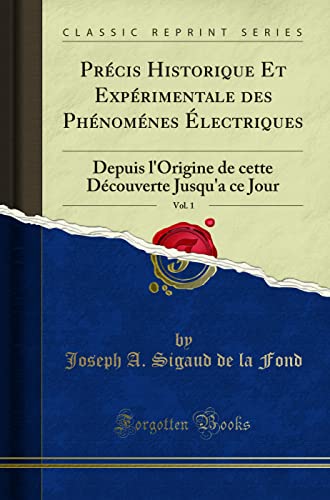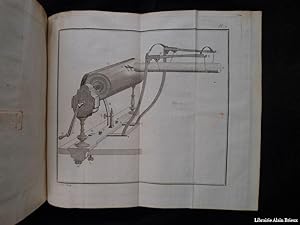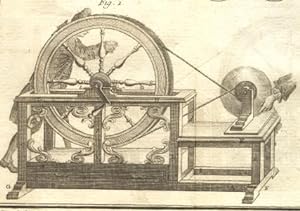précis historique expérimentale phénoménes von fond joseph (4 Ergebnisse)
Produktart
- Alle Product Types
- Bücher (4)
- Magazine & Zeitschriften
- Comics
- Noten
- Kunst, Grafik & Poster
- Fotografien
- Karten
- Manuskripte & Papierantiquitäten
Zustand
- Alle
- Neu
- Antiquarisch (4)
Einband
Weitere Eigenschaften
- Erstausgabe (1)
- Signiert
- Schutzumschlag
- Angebotsfoto (3)
Gratisversand
- Versand nach USA gratis
Land des Verkäufers
Verkäuferbewertung
-
Précis Historique Et Expérimentale des Phénoménes Électriques, Vol. 1 : Depuis l'Origine de cette Découverte Jusqu'a ce Jour (Classic Reprint)
Verlag: Forgotten Books, 2017
ISBN 10: 0265901928ISBN 13: 9780265901922
Anbieter: Buchpark, Trebbin, Deutschland
Buch
Zustand: Sehr gut. Zustand: Sehr gut - Gepflegter, sauberer Zustand. | Seiten: 756.
-
Couverture rigide. Zustand: Bon. XVI-[4]-624-[4] pp., 10 pl. Paris, Hôtel Serpente, 1785, in-8, XVI-[4]-624-[4] pp, 10 pl. depl, veau marbré de l'époque, dos à nerfs et fleuronné, pièce de titre grenat, tranches rouges, Les 10 planches gravées sur cuivre représentent diverses expériences et les principales machines électriques utilisées à cette époque. Seconde édition de cet ouvrage, paru pour la première fois en 1781, qui résume les théories du XVIIIe siècle sur l'électricité. L'auteur (1730-1810), disciple de l'abbé Nollet, évoque l'utilisation de l'électricité en médecine et la théorie de Benjamin Franklin. Cachets de l'Institut catholique de Paris, notamment apposés au revers de planches (légers reports au recto). Coiffe supérieure arasée, coins émoussés, feuillets jaunis. Wheeler Gift n° 505a. The Bakken, p. 107.
-
Précis Historique et Expérimental des Phénomènes Électriques, depuis l'origine de cette découverte jusqua'a jour.
Erscheinungsdatum: 1781
Anbieter: Antiq. F.-D. Söhn - Medicusbooks.Com, Marburg, Deutschland
Buch Erstausgabe
A Paris, Rue et Hôtel Serpente, 1781, 8°, XVI, 752, (2) pp., 9 gefalt. Kupferstichtafeln, feiner Kalbsledereinband, 5 Bünden, mit reichlicher Rückenvergoldung; auf den ersten Seiten leichter Wasserrand; feines Exemplar. FIRST EDITION - mottled calf, back richly. "Work of merit in which the phenomena and laws of electricity and magnetism are discussed at length; electric and magnetic phenomena compared; application to the cure of disease; historical development." "Including a copious account of atmospherical electricity and lightning conductors, with original investigations by the author himself. He claims in the above work to have been the first to use glass plates with electrical machines in 1756, and describes an improved Leyden Jar constructed by him for measuring electricity." "While preparing for his medical degree, Sigaud de la Fond (1730-1810) attended the famous course of public lectures given by Abbé Nollet, who aroused in him such a lively interest in experimental science that Sigaud became first a tutor in philosophy and mathematics and then a demonstrator in experimental science at the Collége Louis-le-Grand. In 1760 he succeeded the Abbé Nollet in his chair at Louis-le-Grand. In 1770 Sigaud became a professor of surgery at the school of Saint-Côme. In 1872 he returned to Bourges, where, after four years, he obtained a chair in physics at the local collége." D.S.B. Wheeler Gift Cat. 505; Ronalds, p.475. Gartrell 491. Ekelöf Cat. 496. Bakken, p.107; DSB XII, pp.427-428; Ekelöf 497; Mottelay, p. 280; Poggendorff II, p.927.
-
Precis Historique et Experimental des Phenomenes Electriques depuis l'Origine de cette Decouverte jusqu'a ce Jour . . . Seconde edition, Revue et augmentee.
Verlag: Rue et Hotel Serpente, 1785., Paris:, 1785
Anbieter: Jeff Weber Rare Books, Montreux, VAUD, Schweiz
200 x 125 mm. 8vo. xvi, [4], 624 pp. Half-title, 10 folding engraved copperplates (by Sellier), [pl. 3 has a manuscript annotation relating to the electrical machine of the author's design], errata; lacks the 2 privilege leaves at end. Contemporary calf-backed marbled boards; cover corners showing, joints mended with kozo. 19th-century stamp on title and elsewhere of Binet Dufour; inscription "Electrobiologique Traitement Electropathique, Par M. Guerin, Boulevard de Strasbourg. . ." Occasional neat manuscript ink corrections or marginalia. Very good. Second edition of a work on electricity and magnetism originally published in 1781. The work mentions a number of electrical devices used to make demonstrations and experiments. This period marks a stark contrast in instruments used for experiments and instruments used for demonstrations. See: Thomas L. Hankins, Robert J. Silverman, Instruments and the Imagination, 2014, p. 58. / "The final, greatly enlarged edition . . . of this comprehensive history of electricity and magnetism, and their development and applications, including use for curing diseases. Benjamin Franklin and his experiments are fully discussed as are those of Gilbert, Hauksbee, Ingenhousz, Nollet, [Volta] and others. Extensive accounts are given of atmospheric electricity and lightning conductors, with some original experiments of the author, who claims to have been the first to use glass plates with electrical machines in 1756. He also described an improved Leyden jar. "A work of merit" (Wheeler Gift). As with his other works on physics, this contains numerous references to chemical experiments and phenomena." :: Neville catalog. / Arranged in five sections, the first offers a history of the origins and progress of electricity to the present period (c.1785) and the Leyden jar. Section II relates to "Leyde" (Leyden Jar invented by Pieter van Musschenbroek of Leiden, with Ewald Kleist also achieving the same invention) and the theories of Benjamin Franklin. Sec. III: Analyzing electricity and comparing it to thunder and magnetism. Within this section deals with meteorology as thunder applied to electrical phenomena, and also the means to divert lightning, the relationship between magnetism and electricity. Sec. IV: Applications made using electrical fluid. With electricity in a void, in electrical fish, electrical properties of tourmaline, "The electric stone." Also: using the electrophorus generator [invented by Johan Carl Wilcke in 1762], producing a static charge. Article V in this section offers more on two pocket-sized electric machines that produce 'some strange phenomena of electric commotion.' The volume finishes with four proposed problems. Adding to all this, the half-title bears an advertisement for his nephew* Rouland, a demonstrator of physics at the University of Paris, and also a course for electrical instruments. See: Rouland, Description des machines electriques a taffetas, de leurs effets et des divers avantages que presentent ces nouveaux appareils, 1785. * [Mottelay suggests "N." for Rouland's first name, though [WorldCat] and other sources do not have his first name]. See: Hankins & Silverman, p. 59. / Provenance: "Binet-Dufour á Houdan s soise proprietaire" :: a French instrument maker, known for their barometers. / Sigaud de la Fond (1730-1810) was a pupil of Nollet, and taught experimental physics in Paris, succeeding him in 1760 at the College Louis-le-Grand, following his mentor. "Sigaud was a prolific writer in the fields of experimental physics, chemistry, medicine, and (apparently as a consequence of his early Jesuit training) theology. Experimental science was a fashionable pursuit among the leisured classes in eighteenth-century France, and Sigaud was one of several illustrious popularizers who satisfied the intellectual appetites and curiosities of an ever-in-creasing number of amateurs of science. Popular interest tended toward the more spectacular examples of natural phenomenon: and lectures accompanied by demonstrations, especially on electricity and on the newly discovered gases, always attracted large and enthusiastic crowds." :: Encyclopedia. / Bakken p.107; Blake p. 418; Ekelof, 497; Gartrell, 492; Mottelay, p. 280; Roy G. Neville II, pp. 475-76; Poggendorff, II, p. 927; Wellcome Library 48238/B; Wheeler Gift 505a. See: Thomas L. Hankins, Robert J. Silverman, Instruments and the Imagination, 2014, p. 59. / See: Isaac Benguigui, Nollet (Jean Antoine, Abbe), Jean Jallabert, Theories electriques du XVIIIe siecle: Correspondance entre l'Abbe Nollet (1700-1770) et le physicien genevois Jean Jallabert (1712-1768), Geneve, 1984, page 40.





